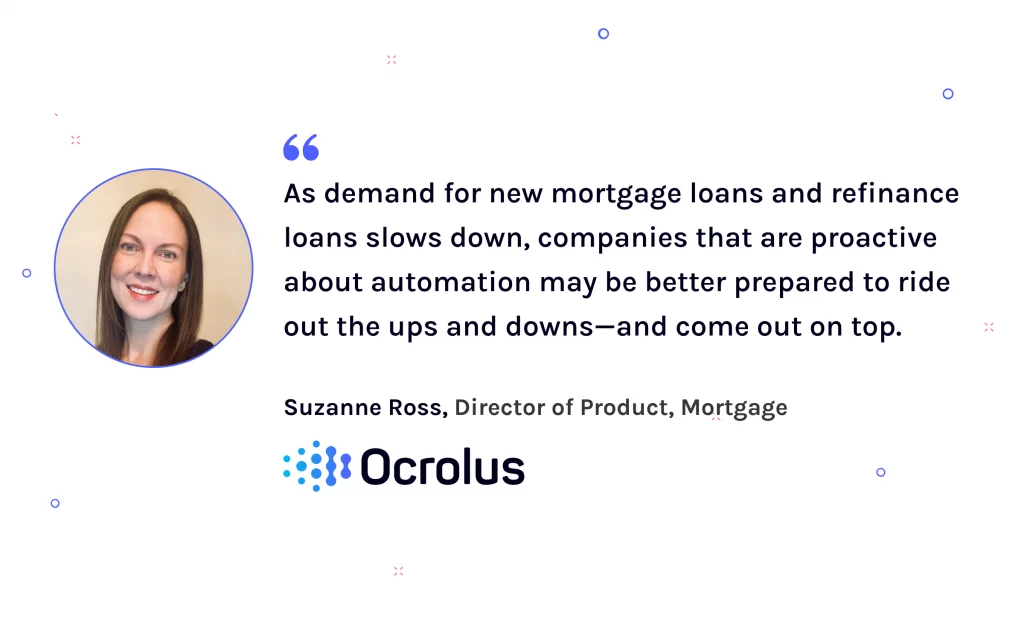This website uses cookies so that we can provide you with the best user experience possible. Cookie information is stored in your browser and performs functions such as recognising you when you return to our website and helping our team to understand which sections of the website you find most interesting and useful.
Why Mortgage Companies Must Be Proactive About Automation

In any endeavor, it pays to be proactive—and proactive automation can make a difference in a mortgage company’s ability to survive and thrive. Anticipation, planning, and preparation help bring about far better outcomes than waiting and reacting. This is particularly true in business process automation, where the technology changes rapidly, and those that wait to implement the latest processes can quickly be left behind.
In the mortgage industry, automation has already become a standard practice for forward-thinking lenders. As demand for new mortgage loans and refinance loans slows down in the current environment, companies that are proactive about automation may be better prepared to ride out the ups and downs—and come out on top.
When mortgage companies proactively adopt automation technologies, they are better able to scale their businesses. Automation prepares mortgage lenders to operate on a leaner budget, and their staffs are available to handle more strategic work that relies on human-centric decision-making. With inflation continuing to rise, now is the time to be proactive and get prepared to run a lean, strategically focused organization, rather than waiting and having to play catch-up down the road.
Mortgage Automation Already Widespread
Automation is finally becoming widespread across the mortgage industry. In fact, Fannie Mae introduced the first automated underwriting system to the industry more than a quarter-century ago. In 2015, the first private company introduced a system that allowed clients to submit information directly into their underwriting system, shortening the underwriting process to about 10 minutes from a manual process that took days.
In recent years, increasing numbers of mortgage companies have joined the trend toward automation, implementing automated tasks such as automatic file sorting, document classification and data extraction, digitized forms, and widgets. The right tools have made it possible to automate many steps in the entire mortgage lending workflow.
Increased Pressure to Stay Competitive
After years of historically low mortgage rates, those rates have begun rising—and are expected to continue rising throughout 2022. In late 2021, the Mortgage Bankers Association predicted a 33% decrease in new mortgage originations in 2022 from the previous year. The organization also predicted a decrease in refinance loans during 2022.
In recent years, mortgage lenders have profited from high volumes due to low-interest rates. However, as demand decreases with rising rates, they will need to transition to more automated systems or implement even more advanced systems for underwriting and analytics in order to maintain the same margins they have experienced over the past few years.
Also, as home buyers and homeowners have become savvier, they increasingly want to work with lenders who use automated, intuitive systems. In a shrinking market, mortgage lenders will need to be prepared to meet those needs and expectations.
Benefits of Being Proactive vs. Reactive
When mortgage companies adopt proactive automation practices rather than waiting to react to the dire need to adapt, they experience several benefits:
Change faster
A mortgage lender that is leanly operating with automation can quickly make institutional changes when necessary. Rather than undertaking a long process of retraining staff, changing automated processes simply takes a few clicks.
Attract more customers
As the market demands more self-service, intuitive, and automated loan processes, lenders that have implemented automation are more attractive to potential customers.
Operate more efficiently
Cutting-edge automated processes allow mortgage firms to operate efficiently and cut costs when necessary.
Scale quickly
When demand picks up, companies using automation can easily scale back up in volume without undergoing the labor-intensive processes of hiring and training new personnel.
Manage compliance easily
Adhering to regulations is an ongoing challenge for lenders, but the right automation technologies can help streamline regulatory compliance and anti-fraud measures and help fight mortgage lending fraud.
There’s Still Time to Be Proactive
Automation has been available to mortgage lenders for some time, and it’s not too late to join the trend. While automated processes are widespread, the mortgage market really hasn’t changed much yet.
Those who want to adopt proactive automation still have time. And when volume is slow, it is the best time to focus on infrastructure and improvements to avoid a reactive approach when the next upswing in business comes. Start working now to proactively adopt automated processes, and you’ll be prepared for whatever comes next in the mortgage industry.
Ocrolus provides intelligent document automation for mortgage lenders, allowing for faster decision-making and greater transparency throughout the process. You can visit our FAQs to see our general mortgage automation frequently asked questions. To learn more about how Ocrolus can help you get proactive about automation, schedule a free demo.






